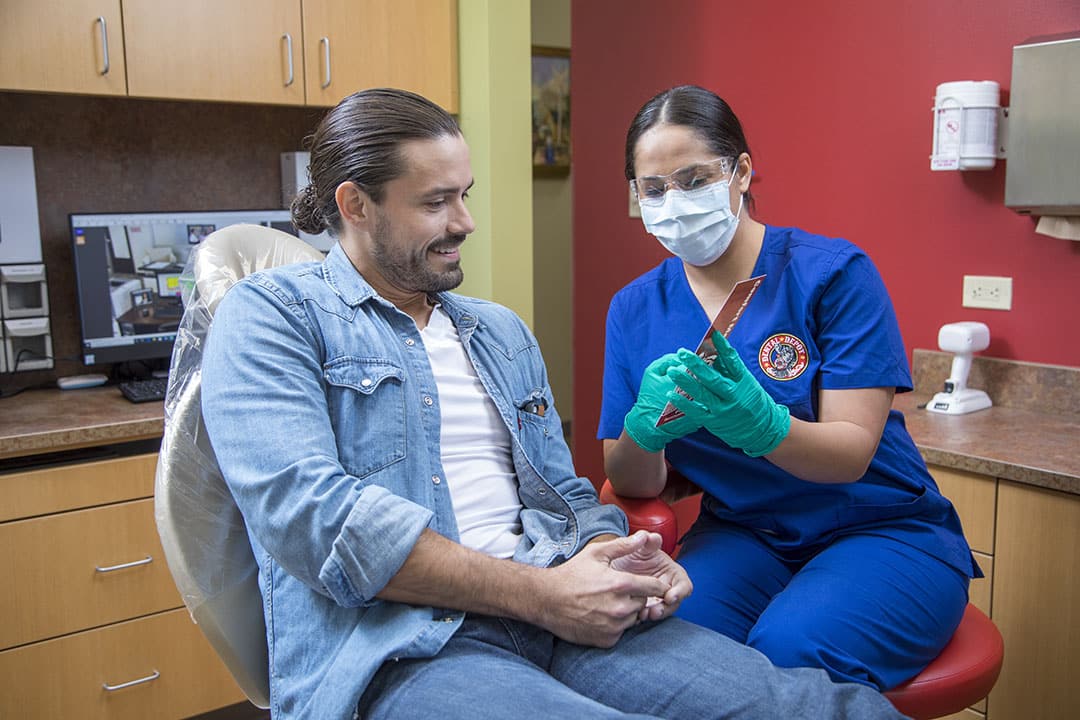It’s likely that you’ve come across the term “dental implants” before, even if you’re not entirely familiar with what they entail. However, “bone grafting” is a phrase that might not be as well-known. Interestingly, bone grafting and dental implants are often closely associated within the dental field.

As a dental patient considering dental implants, you might learn that bone grafting for dental implant surgery could be required. It’s natural to feel apprehensive, as the term “bone grafting” can sound intimidating.
However, there’s no need to worry. Bone grafting is a standard dental procedure that is both pain-free and reliable.
Bone grafting is a procedure necessary when a patient lacks an adequate amount of healthy natural bone in their mouth to support dental implants. Insufficient natural bone can result from:
A bone graft is a surgical procedure aimed at repairing or reconstructing bones by transplanting healthy bone tissue. This process enables the recreation of missing bone and its supporting structures.
Anyone who has experienced tooth loss may require a bone graft before a dental implant can be placed. This holds true even if you seek a dental implant the day after losing the tooth. The socket might be infected, or the lost tooth may not be the right size for immediate replacement.
However, most individuals don’t seek an implant on the same day they lose a tooth. The reason could be financial or logistical. Regardless, bone loss continues to occur for every day the tooth remains missing.
The type of bone that typically encounters issues is known as the alveolar bone. Its primary function is to support and hold your teeth. When a tooth is absent, the alveolar bone starts to atrophy due to inactivity.
Moreover, the jawbone is reinforced and strengthened every time you chew. Consequently, alveolar bone loss can rapidly lead to jawbone loss as well.
Keep in mind that dental implants rely on osseointegration to function—meaning, the implant must bond with the bone to establish a stable foundation for the crown. If there is no bone available, placing an implant becomes unattainable.
There are several types of bone grafts, and the one we use depends on the extent of the damage you’re experiencing and the location of the missing tooth.
The most common type of bone graft is called a socket graft. Its primary purpose is to prevent the atrophy of the alveolar bone before it happens. We usually place bone from a human donor directly into the socket, which also helps prevent the socket from collapsing. After a socket graft, you’ll typically be ready for your implant in 4-6 months. Additionally, having one of these grafts can reduce post-operative pain from the implant surgery.
The next type of bone graft is called a lateral ridge preservation graft. These grafts are used to widen the jawbone to accommodate a dental implant. Again, we typically use human donor bones for this.
The block bone graft is another type we use when there are significant defects in the jawbone. To perform this graft, we harvest a small block of bone from the back of the jaw. We place the block into the defect and secure it with small titanium screws. Both the lateral ridge preservation graft and block bone graft usually take 4 to 6 months to heal.
Lastly, there’s the sinus lift procedure, which often uses equine bone to expand the graft. The equine bone may be combined with human donor bone. This procedure is necessary when a patient needs an implant in the upper jaw, which isn’t typically stable enough to hold the implants on its own.
So why use equine bone? It offers two unique advantages: it doesn’t dissolve as quickly as human bone and is more similar to human bone microscopically. The equine bone forms a “scaffold” that supports additional bone growth in the sinus.
Due to the anatomy of the sinus cavity, healing typically takes 8-12 months.
Absolutely not! Bone grafts are performed in our office on a daily basis and are considered an outpatient procedure. During the process, patients are typically sedated to ensure comfort. Pain during the healing process should be minimal and once the graft is complete, patients will be ready for their dental implants. A bone graft is the first step in achieving a beautiful replacement tooth.
In the case of a sinus lift procedure, we use equine bone to expand the graft. Equine bone offers two advantages as it doesn’t dissolve as quickly as human bone and is microscopically similar to human bone. This creates a “scaffold” that supports additional bone growth in the sinus. Healing time for this procedure usually takes 8-12 months due to the anatomy of the sinus cavity.
No. However, there is no way to know for sure if you’ll require a bone graft without a consultation. During your consultation, our team will evaluate your situation and determine if a bone graft is necessary, and if so, what type of graft is required. Don’t hesitate to schedule your consultation with us today.
Dr. Kana is dedicated in providing the highest level of care. He and the staff are committed to education and expanding knowledge. He has completed over 1,000 hours of continuing education. Dr. Kana hopes that being accessible to all of his patients, strong community feel and values, and strong patient/customer service is what will help our practice and community grow.
